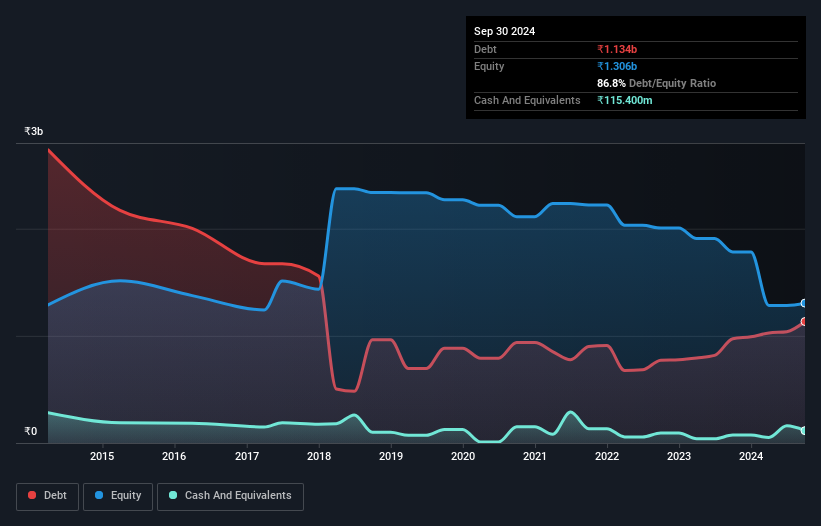- India
- /
- Consumer Durables
- /
- NSEI:MIRCELECTR
Here's Why MIRC Electronics (NSE:MIRCELECTR) Can Afford Some Debt
Warren Buffett famously said, 'Volatility is far from synonymous with risk.' When we think about how risky a company is, we always like to look at its use of debt, since debt overload can lead to ruin. We can see that MIRC Electronics Limited (NSE:MIRCELECTR) does use debt in its business. But is this debt a concern to shareholders?
When Is Debt A Problem?
Debt is a tool to help businesses grow, but if a business is incapable of paying off its lenders, then it exists at their mercy. If things get really bad, the lenders can take control of the business. However, a more common (but still painful) scenario is that it has to raise new equity capital at a low price, thus permanently diluting shareholders. Of course, the upside of debt is that it often represents cheap capital, especially when it replaces dilution in a company with the ability to reinvest at high rates of return. When we examine debt levels, we first consider both cash and debt levels, together.
View our latest analysis for MIRC Electronics
What Is MIRC Electronics's Net Debt?
As you can see below, at the end of September 2024, MIRC Electronics had ₹1.13b of debt, up from ₹973.6m a year ago. Click the image for more detail. On the flip side, it has ₹115.4m in cash leading to net debt of about ₹1.02b.

A Look At MIRC Electronics' Liabilities
According to the last reported balance sheet, MIRC Electronics had liabilities of ₹3.90b due within 12 months, and liabilities of ₹324.2m due beyond 12 months. On the other hand, it had cash of ₹115.4m and ₹2.16b worth of receivables due within a year. So its liabilities outweigh the sum of its cash and (near-term) receivables by ₹1.95b.
This deficit isn't so bad because MIRC Electronics is worth ₹4.71b, and thus could probably raise enough capital to shore up its balance sheet, if the need arose. However, it is still worthwhile taking a close look at its ability to pay off debt. There's no doubt that we learn most about debt from the balance sheet. But it is MIRC Electronics's earnings that will influence how the balance sheet holds up in the future. So when considering debt, it's definitely worth looking at the earnings trend. Click here for an interactive snapshot.
In the last year MIRC Electronics wasn't profitable at an EBIT level, but managed to grow its revenue by 11%, to ₹9.7b. We usually like to see faster growth from unprofitable companies, but each to their own.
Caveat Emptor
Over the last twelve months MIRC Electronics produced an earnings before interest and tax (EBIT) loss. To be specific the EBIT loss came in at ₹352m. When we look at that and recall the liabilities on its balance sheet, relative to cash, it seems unwise to us for the company to have any debt. So we think its balance sheet is a little strained, though not beyond repair. For example, we would not want to see a repeat of last year's loss of ₹478m. So to be blunt we do think it is risky. There's no doubt that we learn most about debt from the balance sheet. But ultimately, every company can contain risks that exist outside of the balance sheet. These risks can be hard to spot. Every company has them, and we've spotted 3 warning signs for MIRC Electronics (of which 1 is a bit concerning!) you should know about.
Of course, if you're the type of investor who prefers buying stocks without the burden of debt, then don't hesitate to discover our exclusive list of net cash growth stocks, today.
New: Manage All Your Stock Portfolios in One Place
We've created the ultimate portfolio companion for stock investors, and it's free.
• Connect an unlimited number of Portfolios and see your total in one currency
• Be alerted to new Warning Signs or Risks via email or mobile
• Track the Fair Value of your stocks
Have feedback on this article? Concerned about the content? Get in touch with us directly. Alternatively, email editorial-team (at) simplywallst.com.
This article by Simply Wall St is general in nature. We provide commentary based on historical data and analyst forecasts only using an unbiased methodology and our articles are not intended to be financial advice. It does not constitute a recommendation to buy or sell any stock, and does not take account of your objectives, or your financial situation. We aim to bring you long-term focused analysis driven by fundamental data. Note that our analysis may not factor in the latest price-sensitive company announcements or qualitative material. Simply Wall St has no position in any stocks mentioned.
About NSEI:MIRCELECTR
MIRC Electronics
Engages in manufacturing and trading of electronics and consumer durables in India.
Adequate balance sheet with low risk.
Similar Companies
Market Insights
Community Narratives



